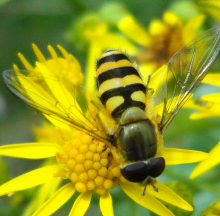News
28.12.2015 | permalink
Decline in wild bee population threatens U.S. crop production, new study

Wild bees are on the decline in many important agricultural regions of the United States, a trend that will increase costs for US farmers and may even destabilise crop production over time, a new study warns. According to the first national map of bee populations, published in the journal Proceedings of the National Academy of Sciences, wild bee abundance in the US decreased by 23% between 2008 and 2013. A research team identified 139 counties in key agricultural regions of California, the Pacific Northwest, the upper Midwest and Great Plains, west Texas and the southern Mississippi River valley that have the most worrisome mismatch between falling wild bee supply and rising crop pollination demand. “Until this study, we didn’t have a national mapped picture about the status of wild bees and their impacts on pollination,” says Insu Koh, a researcher at the University of Vermont’s Gund Institute for Ecological Economics. The new nationwide assessment comprises 39% of the pollinator-dependent crop area in the United States. These counties grow crops such as almonds, pumpkins, squashes, blueberries, watermelons, peaches and apples that are highly dependent on pollinators. “These are the crops most likely to run into pollination trouble – whether that’s increased costs for managed pollinators, or even destabilized yields,” says Taylor Ricketts, director of the Gund Institute. But the study also mapped counties that grow less-pollinator-dependent crops including soybeans, canola and cotton. Wild bees are important pollinators; in the U.S. alone there are at least 4,000 species of wild bees. Along with managed honey bees, they ensure stable pollination to agriculture and wild plant communities. According to estimates, these pollination services contribute over $3 billion to the U.S. agricultural economy each year. But pesticides, climate change and diseases are threatening wild bees. The new study shows that their decline may also be caused by the conversion of natural bee habitat into cropland. In 11 key states with declining bee populations, the amount of land tilled to grow corn increased by 200% in five years, replacing grasslands and pastures that once supported bee populations. The authors blame the increased demand for corn in biofuel production for the destruction of bee’s natural habitats. “By highlighting regions with loss of habitat for wild bees, government agencies and private organizations can focus their efforts (…) to support these important pollinators for more sustainable agricultural and natural landscapes,” said Rufus Isaacs, one of the co-authors on the study. The study followed a 2014 memorandum by President Barack Obama creating a task force to study pollinator losses. (ab)

